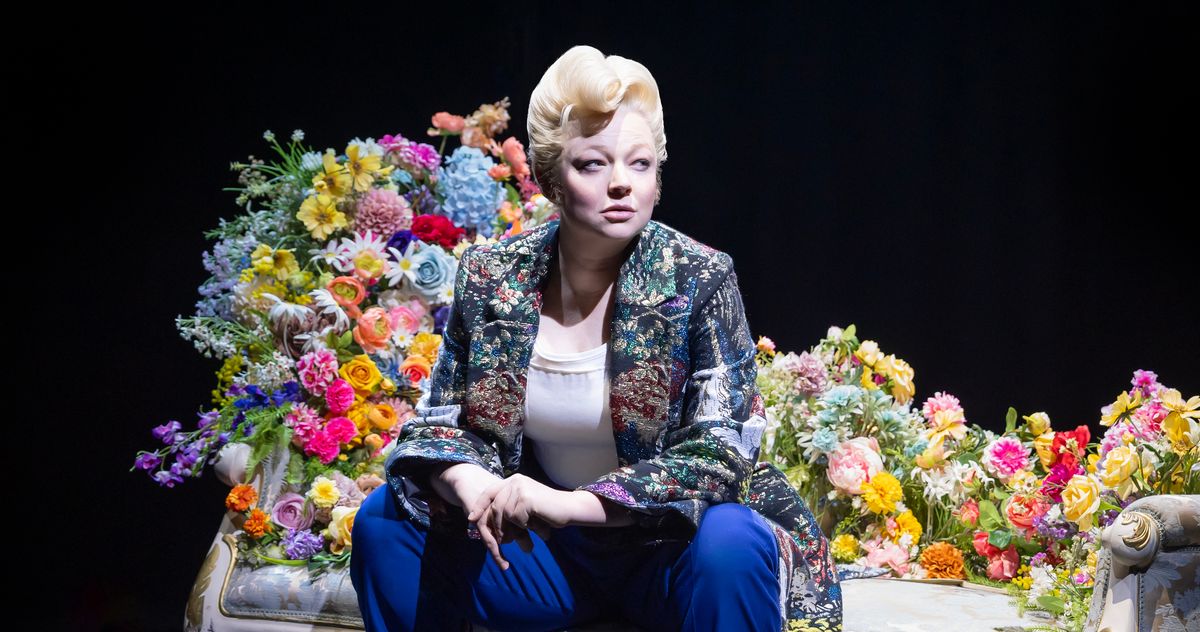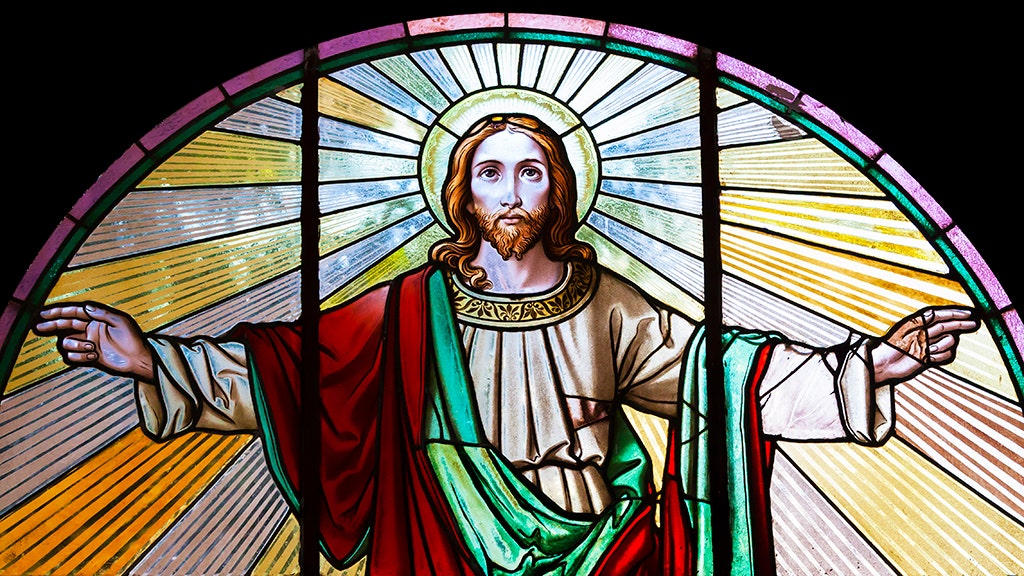“There was something terribly enthralling in the exercise of influence,” wrote Oscar Wilde in 1890. “No other activity was like it. To project one’s soul into some gracious form … to hear one’s own intellectual views echoed back to one … to convey one’s temperament into another as though it were a subtle fluid or a strange perfume: there was a real joy in that — perhaps the most satisfying joy left to us in an age so limited and vulgar as our own, an age grossly carnal in its pleasures, and grossly common in its aims.”
There’s no knowing, without being told, exactly what tiny original seed gave rise to any complex work of art, but I wouldn’t be surprised if the Australian director Kip Williams sat down with Wilde’s The Picture of Dorian Gray one day, happened across those lines, and immediately dropped the book in a “Eureka!” moment. In his intoxicating whirl of a production—the first of a gothic trilogy, including Dracula and Strange Case of Dr. Jekyll and Mr. Hyde, in which the director has developed his ultra-athletic, multi-camera “cine-theatre” technique—that passage, slightly trimmed, bursts from the stage as if fired from a confetti cannon, its sinister contemporary resonances glittering as they float down upon our heads. The solipsistic decadence of influencer culture, the corrosive obsession with youth and beauty, the urge to freeze one’s face and body in their most supposedly perfect form, age and ugliness all smoothed away with the filter of a brush, or the brush of a filter — it’s all there in Wilde’s ironically ever-young novella, and it’s all just a click away on any smartphone.
But it’s a mark of Williams’s savvy—combined with the expert calibrations of his adaptation’s solo performer, Sarah Snook—that neither this moment nor any other in the show is approached with the heavy highlighter of relevancy. Wilde, with his withering disdain for moral snobbery, would have hated that, and this Dorian Gray stays true to its originator’s brilliant ghost, even as it winkingly inserts a phone selfie here and a creepy TikTok filter there. The show arrives on Broadway trailing acclaim from its London run, including an Olivier for Snook, and it works because it is, first and foremost, a sensory feast. Fast, clever, delicious, and performed by Snook with the giddy virtuosity of Simone Biles executing a floor routine, it reaches the gut and the heart lightly, thrusting like a fencer, by way of its playfulness and spectacle. It doesn’t need a bullhorn to talk about the now — just a great story and an acrobatic actor.
Well, that, and a fleet of onstage camerapeople and stagehands, armed with rigs and wigs and ready to buoy Snook as she powers through two hours of nonstop banter and gymnastics. This heroic pit crew gets to bow alongside her at the play’s end, and they’ve more than earned it. Clad in black and hovering around the star, dancing adroitly in and out of the shadows, Williams’s cine-theatre army functions like a troupe of bunraku puppeteers. Together, along with video designer David Bergman, they help bring a single colorful human being to life, assisting in its transformations among 26 characters, even enabling that body to talk to itself. On the empty stage of the Music Box Theatre, scenic designer Marg Horwell (who also created the show’s candy-hued -semiVictorian drag) brings in a progression of floating screens and, eventually, clever diorama-like boxes, and as Snook whizzes about the physical space, she often encounters her own form, prerecorded and projected meticulously into the action, ready to conduct a scene with her living body in real time. Occasionally, she even quibbles with herself: In a lacy tunic and angelic blonde floof of a wig as Dorian, she and the story’s narrator—Snook in street clothes, looming large on a screen behind herself—find themselves trying to say the same line at the same time. They falter and giggle, doing a version of that dance where two people meeting in a hallway go the same way, then go the other way, then collapse into awkwardness. At last, Dorian-Snook bursts out imploringly, “I thought Dorian could do this next bit?” and Narrator-Snook tiptoes dutifully away.
This kind of mischief—as well as a sensuous indulgence in color—is what separates Williams’s brand of screen-driven theater from that of directors like Jamie Lloyd or Lloyd’s spiritual predecessor Ivo van Hove. Lloyd’s worlds are shiny brutalist black boxes, at once austere and conspicuously expensive, and Van Hove’s are if anything even more severe. In Dorian Gray, Williams seems more interested in emptying the whole toy chest out onto the floor, figuring out just about everything a camera and an actor might be able to do in a space, and then doing it. The result is a heady rush, propulsive, gleefully ingenious, and lush even in its relative spareness. Though there were certainly moments in which I longed for more of Snook’s physical presence—sometimes hidden away while the onscreen images assume dominance—or in which, especially near the show’s galloping climax, I craved a downshift from the relentless presto tempo, Dorian’s uninterrupted wave of craft and energy is certainly enough to sweep you along. As a stagehand races across the space to grab Snook’s abandoned shoes, or another slips her into a new wig while a camera orbits her like a voyeuristic moon and she continues to spout Wildean wit, little gripes quickly recede. They’re somewhere back there in the rearview, but it’s a pleasure just to lean back and let the car race on.
Especially because Snook is such a dexterous driver. From the show’s first moments in which we encounter her face, massive on that towering central screen, her eyes sparkle and her body effervesces enthusiasm. It makes sense that a project like this one might enthrall an actor after a deep dive into something like Succession. There, over years, she honed a character down to her tortured core; here, she can shapeshift, leaping between stances and voices, winking at us across the footlights, calling on her own agility and adrenaline on a nightly basis. (If her current performance doesn’t leave you out of breath, just add to that the fact that she began rehearsing the role with a six-month-old baby, “in the depths,” as she told the New Yorker, “of pumping and breastfeeding.”) Yes, all of Wilde’s characters—from naïve, doomed Dorian, whose portrait will remain gorgeous while his soul rots, to the anxious, goodhearted painter Basil Hallward, to the louche aristocrat and exerciser of devilish influence Lord Henry Wotton—have their own distinctive costumes and coiffures, but it’s Snook who’s vaulting between their humanities, filling out figures both nuanced and wonderfully broad on a mostly empty stage. There’s a marvelous sequence in which she appears as an actress named Sibyl Vane, beloved by Dorian and performing in a chintzy Romeo and Juliet: Inside a toy-scale replica of a Victorian theater, only Snook’s head is visible, emerging from the stage floor in an absurd wig, dwarfing Sibyl’s fellow actors, who are little marionettes, like the grimacing lovechild of Goldilocks and Jabba the Hutt. Sibyl, we later learn in a twist that opens the door on the story’s descent into tragedy, is intentionally sabotaging her own performance — but in the moment, watching Snook groan and garble as a histrionic head on a plate is its own delight.
In another production high point, Lord Henry’s aunt, Lady Agatha, throws a luncheon party, and Snook—in the flesh as Henry—gets to interact with no fewer than six prerecorded selves, done up in flounces and frills and snickering over Wildean gems like: “What are American dry-goods?” “Dry goods? American novels.” Yet, amid all this bubbliness, she still navigates an increasingly nasty, ultimately harrowing arc for the story’s protagonist. As poor, lost, beautiful Dorian becomes more and more shallow and cruel—with only the portrait locked away in his attic reflecting the decay of his body and soul—Williams and Snook together locate Wilde’s evocation of a particularly insidious kind of societal cancer. “There were times,” this Dorian muses as he wanders the portrait gallery in his home (in which Williams has ensured that every painting subtly bears Snook’s features), “when it appeared to Dorian Gray that the whole of history was merely the record of his own life.” This is the kind of metastasization of ego that gives rise to men like the ones currently ripping our government to shreds — men who look out at the world and see only so many mirrors gazing back at them. What does it matter how much or whom one destroys when no one else is real, when you and your appetites are all? Prophet as much as artist, Wilde could see the future in the instant, and Williams, Snook, and company charismatically and chillingly tap the immortality of his vision.
The Picture of Dorian Gray is at the Music Box Theatre.













